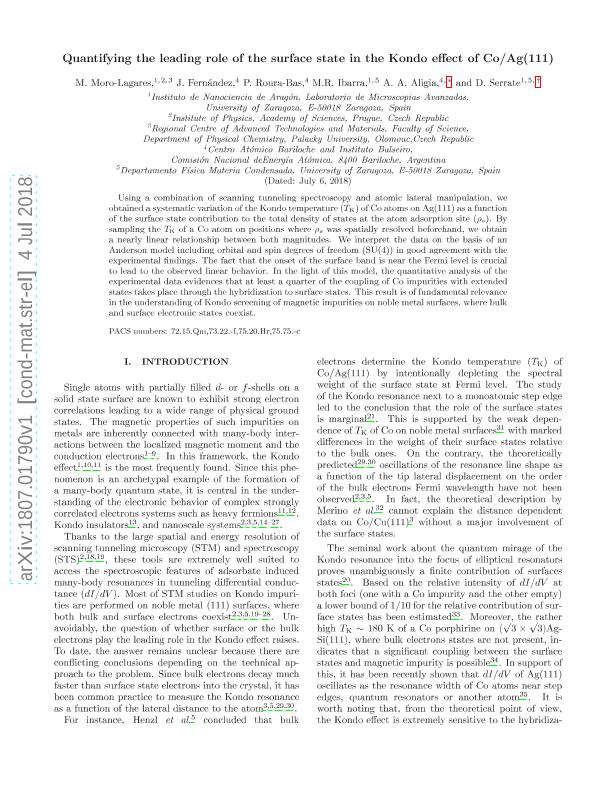Mostrar el registro sencillo del ítem
dc.contributor.author
Moro Lagares, M.
dc.contributor.author
Fernández, Joaquín

dc.contributor.author
Roura Bas, Pablo Gines

dc.contributor.author
Ibarra, M.R.
dc.contributor.author
Aligia, Armando Ángel

dc.contributor.author
Serrate, D.
dc.date.available
2020-08-24T18:07:50Z
dc.date.issued
2018-06-26
dc.identifier.citation
Moro Lagares, M.; Fernández, Joaquín; Roura Bas, Pablo Gines; Ibarra, M.R.; Aligia, Armando Ángel; et al.; Quantifying the leading role of the surface state in the Kondo effect of Co/Ag(111); American Physical Society; Physical Review B: Condensed Matter and Materials Physics; 97; 23; 26-6-2018; 1-9
dc.identifier.issn
2469-9969
dc.identifier.uri
http://hdl.handle.net/11336/112271
dc.description.abstract
Using a combination of scanning tunneling spectroscopy and atomic lateral manipulation, we obtained a systematic variation of the Kondo temperature TK of Co atoms on Ag(111) as a function of the surface-state contribution to the total density of states at the atom adsorption site ρs. By sampling the TK of a Co atom on positions where ρs was spatially resolved beforehand, we obtain a nearly linear relationship between the magnitudes. We interpret the data on the basis of an Anderson model including orbital and spin degrees of freedom [SU(4)] in good agreement with the experimental findings. The fact that the onset of the surface band is near the Fermi level is crucial to finding the observed linear behavior. In light of this model, the quantitative analysis of the experimental data evidences that at least a quarter of the coupling of Co impurities with extended states takes place through the hybridization to surface states. This result is of fundamental relevance in the understanding of Kondo screening of magnetic impurities on noble-metal surfaces, where bulk and surface electronic states coexist.
dc.format
application/pdf
dc.language.iso
eng
dc.publisher
American Physical Society

dc.rights
info:eu-repo/semantics/openAccess
dc.rights.uri
https://creativecommons.org/licenses/by/2.5/ar/
dc.subject
KONDO EFFECT
dc.subject
SURFACE STATES
dc.subject.classification
Física de los Materiales Condensados

dc.subject.classification
Ciencias Físicas

dc.subject.classification
CIENCIAS NATURALES Y EXACTAS

dc.title
Quantifying the leading role of the surface state in the Kondo effect of Co/Ag(111)
dc.type
info:eu-repo/semantics/article
dc.type
info:ar-repo/semantics/artículo
dc.type
info:eu-repo/semantics/publishedVersion
dc.date.updated
2019-10-15T17:55:35Z
dc.journal.volume
97
dc.journal.number
23
dc.journal.pagination
1-9
dc.journal.pais
Estados Unidos

dc.journal.ciudad
Nueva York
dc.description.fil
Fil: Moro Lagares, M.. Biology Centre of the Academy of Sciences of the Czech Republic; República Checa. Palacky University; República Checa. Universidad de Zaragoza. Instituto de Nanociencia de Aragón; España
dc.description.fil
Fil: Fernández, Joaquín. Consejo Nacional de Investigaciones Científicas y Técnicas. Centro Científico Tecnológico Conicet - Patagonia Norte; Argentina. Comisión Nacional de Energía Atómica. Gerencia del Área de Energía Nuclear. Instituto Balseiro; Argentina
dc.description.fil
Fil: Roura Bas, Pablo Gines. Comisión Nacional de Energía Atómica. Gerencia del Área de Energía Nuclear. Instituto Balseiro; Argentina. Consejo Nacional de Investigaciones Científicas y Técnicas. Centro Científico Tecnológico Conicet - Patagonia Norte; Argentina
dc.description.fil
Fil: Ibarra, M.R.. Universidad de Zaragoza; España
dc.description.fil
Fil: Aligia, Armando Ángel. Consejo Nacional de Investigaciones Científicas y Técnicas. Centro Científico Tecnológico Conicet - Patagonia Norte; Argentina. Comisión Nacional de Energía Atómica. Gerencia del Área de Energía Nuclear. Instituto Balseiro; Argentina
dc.description.fil
Fil: Serrate, D.. Universidad de Zaragoza; España
dc.journal.title
Physical Review B: Condensed Matter and Materials Physics

dc.relation.alternativeid
info:eu-repo/semantics/altIdentifier/url/https://journals.aps.org/prb/abstract/10.1103/PhysRevB.97.235442
dc.relation.alternativeid
info:eu-repo/semantics/altIdentifier/doi/http://dx.doi.org/10.1103/PhysRevB.97.235442
dc.relation.alternativeid
info:eu-repo/semantics/altIdentifier/url/https://arxiv.org/abs/1807.01790
Archivos asociados
